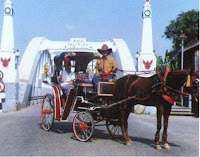The charming city of horse drawn carriages and province with the king’s stable of white elephants at the Thailand Elephant Conservation Center.
Most visitors simply visit Lampang to see the Thailand Elephant Conservation Center, bypassing Lampang town on their way to Chiang Mai and provinces farther north. However, while the elephant center is certainly a must-see attraction, those willing to spend some time in the provincial capital are generally surprised by the charming and somewhat unusual town and province of Lampang.
Famous for its horse-drawn carriages and sporting a rooster on its provincial emblem (the bird also honored with a large statue in the center of town), Lampang boasts a long history of human settlements within the Wang River basin, some of which date back more than 1,000 years. Lampang is rich in archaeological evidence from the kingdoms of Hariphunchai, Lanna, and Burma.
The horse and carriage, a mode of local transportation that has survived the introduction of automobiles to Lampang, is a fun way to explore the surprisingly large town, which features a number of beautiful old temples. The rooster statue, which you are likely to pass along the way, is a much older symbol of Lampang, dating back to the city’s former name, Kukutthanakorn, or City of Roosters, a name that was derived from a local legend about a white rooster that was sent by the Brahmin God Indra to wake the local inhabitants so they could give alms to the Lord Buddha, who was purportedly visiting the town.
On the road from Lampang to Chiang Mai is the Thailand Elephant Conservation Center, the oldest and only government sponsored elephant center in Thailand, where the King’s white elephants are housed, visitors can learn about elephants, and elephant demonstrations are regularly performed.
Famous for its horse-drawn carriages and sporting a rooster on its provincial emblem (the bird also honored with a large statue in the center of town), Lampang boasts a long history of human settlements within the Wang River basin, some of which date back more than 1,000 years. Lampang is rich in archaeological evidence from the kingdoms of Hariphunchai, Lanna, and Burma.
The horse and carriage, a mode of local transportation that has survived the introduction of automobiles to Lampang, is a fun way to explore the surprisingly large town, which features a number of beautiful old temples. The rooster statue, which you are likely to pass along the way, is a much older symbol of Lampang, dating back to the city’s former name, Kukutthanakorn, or City of Roosters, a name that was derived from a local legend about a white rooster that was sent by the Brahmin God Indra to wake the local inhabitants so they could give alms to the Lord Buddha, who was purportedly visiting the town.
On the road from Lampang to Chiang Mai is the Thailand Elephant Conservation Center, the oldest and only government sponsored elephant center in Thailand, where the King’s white elephants are housed, visitors can learn about elephants, and elephant demonstrations are regularly performed.
Lampang city is the capital of the province of the same name, a city that features horse drawn carriages, relaxing riverside bars and restaurants, a number of spectacular Buddhist temples, and a friendly, laid-back local population. Just outside of the city, on the road to Chiang Mai, the Thailand Elephant Conservation Center is one of the premier venues for visitors to learn about elephants and watch elephant demonstrations.
If you wish to participate in the mahout training course at the Thai Elephant Conservation Center (typically only run during the high season) you must book well in advance.


